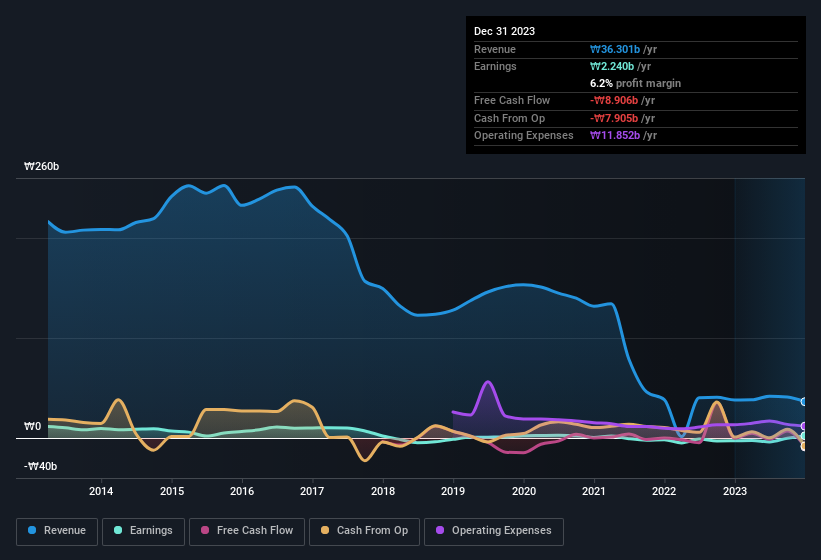- South Korea
- /
- Software
- /
- KOSDAQ:A039310
There Are Some Reasons To Suggest That Sejoong's (KOSDAQ:039310) Earnings Are A Poor Reflection Of Profitability
Solid profit numbers didn't seem to be enough to please Sejoong Co., Ltd.'s (KOSDAQ:039310) shareholders. We think that they might be concerned about some underlying details that our analysis found.
View our latest analysis for Sejoong

Zooming In On Sejoong's Earnings
In high finance, the key ratio used to measure how well a company converts reported profits into free cash flow (FCF) is the accrual ratio (from cashflow). To get the accrual ratio we first subtract FCF from profit for a period, and then divide that number by the average operating assets for the period. The ratio shows us how much a company's profit exceeds its FCF.
Therefore, it's actually considered a good thing when a company has a negative accrual ratio, but a bad thing if its accrual ratio is positive. While having an accrual ratio above zero is of little concern, we do think it's worth noting when a company has a relatively high accrual ratio. To quote a 2014 paper by Lewellen and Resutek, "firms with higher accruals tend to be less profitable in the future".
For the year to December 2023, Sejoong had an accrual ratio of 0.21. Therefore, we know that it's free cashflow was significantly lower than its statutory profit, which is hardly a good thing. Even though it reported a profit of ₩2.24b, a look at free cash flow indicates it actually burnt through ₩8.9b in the last year. Coming off the back of negative free cash flow last year, we imagine some shareholders might wonder if its cash burn of ₩8.9b, this year, indicates high risk. However, that's not all there is to consider. We can see that unusual items have impacted its statutory profit, and therefore the accrual ratio. One positive for Sejoong shareholders is that it's accrual ratio was significantly better last year, providing reason to believe that it may return to stronger cash conversion in the future. Shareholders should look for improved cashflow relative to profit in the current year, if that is indeed the case.
Note: we always recommend investors check balance sheet strength. Click here to be taken to our balance sheet analysis of Sejoong.
The Impact Of Unusual Items On Profit
Given the accrual ratio, it's not overly surprising that Sejoong's profit was boosted by unusual items worth ₩547m in the last twelve months. While we like to see profit increases, we tend to be a little more cautious when unusual items have made a big contribution. When we analysed the vast majority of listed companies worldwide, we found that significant unusual items are often not repeated. And, after all, that's exactly what the accounting terminology implies. Sejoong had a rather significant contribution from unusual items relative to its profit to December 2023. As a result, we can surmise that the unusual items are making its statutory profit significantly stronger than it would otherwise be.
Our Take On Sejoong's Profit Performance
Summing up, Sejoong received a nice boost to profit from unusual items, but could not match its paper profit with free cash flow. For the reasons mentioned above, we think that a perfunctory glance at Sejoong's statutory profits might make it look better than it really is on an underlying level. If you'd like to know more about Sejoong as a business, it's important to be aware of any risks it's facing. For instance, we've identified 2 warning signs for Sejoong (1 is a bit concerning) you should be familiar with.
Our examination of Sejoong has focussed on certain factors that can make its earnings look better than they are. And, on that basis, we are somewhat skeptical. But there are plenty of other ways to inform your opinion of a company. Some people consider a high return on equity to be a good sign of a quality business. While it might take a little research on your behalf, you may find this free collection of companies boasting high return on equity, or this list of stocks that insiders are buying to be useful.
New: Manage All Your Stock Portfolios in One Place
We've created the ultimate portfolio companion for stock investors, and it's free.
• Connect an unlimited number of Portfolios and see your total in one currency
• Be alerted to new Warning Signs or Risks via email or mobile
• Track the Fair Value of your stocks
Have feedback on this article? Concerned about the content? Get in touch with us directly. Alternatively, email editorial-team (at) simplywallst.com.
This article by Simply Wall St is general in nature. We provide commentary based on historical data and analyst forecasts only using an unbiased methodology and our articles are not intended to be financial advice. It does not constitute a recommendation to buy or sell any stock, and does not take account of your objectives, or your financial situation. We aim to bring you long-term focused analysis driven by fundamental data. Note that our analysis may not factor in the latest price-sensitive company announcements or qualitative material. Simply Wall St has no position in any stocks mentioned.
About KOSDAQ:A039310
Sejoong
Operates as a travel services and information technology company.
Flawless balance sheet with low risk.
Similar Companies
Market Insights
Community Narratives



